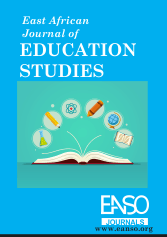How Teachers of English Use Writing Approaches when Teaching Composition Writing: The Case of Three Selected Secondary Schools in Central West Education Division-Malawi
Abstract
Since the inception of teaching English as a Second Language (ESL) writing, educators and researchers have developed various writing approaches to address the needs of learners. This paper examines how English teachers apply these approaches in teaching ESL writing, focusing on key methodologies such as the product writing approach, genre writing approach, and process writing approach. The advantages and limitations of each approach are discussed. The study employed a qualitative research methodology, including in-depth interviews, focus group discussions, classroom observations, literature reviews, and the analysis of documents and students' exercise books. Content analysis was used to transcribe, categorize, and code the data. The study aimed to provide specific examples of empirical findings that illustrate effective strategies teachers use to enhance writing competence in composition instruction. The findings highlight that teachers predominantly use the product-oriented approach when teaching composition writing, particularly in tasks such as writing full-length compositions (350-500 words), answering comprehension questions, and summarizing texts. However, this approach often led to challenges, including students' inability to write meaningfully due to surface-level errors, a lack of ideas or vocabulary, poor organizational skills, and general difficulties in composing effectively. This study contributes to the understanding of how English teachers adapt writing approaches based on their specific contexts and the needs of their learners. The implications of these findings are also discussed
Downloads
References
Badger, R. & White G. (2000). A process genre approach to teaching writing. ELT Journal, 54(2): 153–160
Bazerman, C. (2013). Understanding the lifelong journey of writing development. Infancia Y Aprendizaje, 36(4), 421-441.
Brown, H. D. (2001). Teaching by principles: An interactive approach to language pedagogy. Upper Saddle River, NJ: Prentice Hall.
Canagarajah, A. S. (2006). Negotiating the local in English as a lingua franca. Annual Review of Applied Linguistics, 26, 197-218.
Cohen, L., Manion, L., & Morrison, K. (2002). Research methods in education, (5th ed.). London: Routledge.
Erazmus, E. (1960). Second language composition teaching at the intermediate level. Language Learning, 10, 25-31.
Hyland, K. (2003). Second language writing. Cambridge: Cambridge University Press
Kaplan, R. (1996). Cultural thought patterns in intercultural education. Language Learning, 16, 1 20
Lavelle, E., & Bushrow, K. (2007). Writing approaches of graduate students. Educational Psychology.27(6): 807–822.
Leki, I. (1992). Understanding ESL Writers: A guide for teachers. Portsmouth, New Hampshire: Boynton/Cook Publishers
McDonough, S. (1985). Academic writing practice. ELT Journal, 39 (4), 244-247.
Mangelsdorf, K. (1992). Peer reviews in the composition classroom. ELT Journal, 46 (3), 274 283.
Ministry of Education Science and Technology (2013). Secondary school teaching syllabus: English. Domasi: MIE.
Raimes, A. (1991). Out of the woods: emerging traditions in the teaching of writing, TESOL Quarterly, 25 (3), 407-430.
Richards, J. C., & Rodgers. T. (2001). Approaches and methods to language teaching. Cambridge: CUP.
Senekane, M. M. (2010). An exploration of strategies employed in English additional language, large class secondary school in Maseru, Lesotho. Unpublished master dissertation, University of Witwatersrand, Faculty of Linguistics, Johannesburg.
Spack, R. (1984). Invention strategies and the ESL college composition student. TESOL Quarterly, 18 (4), 649-670.
Tribble, C. (1996). Writing. Oxford: Oxford University Press.
Vygotsky L. S. (1978). Mind in Society: Development of Higher Psychological Processes.
Yin, J., Xu, M. & Yang, H. (2003). Training college students to study on their own. Journal of Hainan Normal University (Social Sciences), 16 (4), 123-125. Associates, Third edition.
Zamel, V. (1983). The composing processes of advanced ESL students: Six case studies. TESOL Quarterly. 17, 165-187.
Copyright (c) 2024 Chimwemwe Mzinganjira, Amos Chauma, PhD, Syned Mthatiwa, PhD

This work is licensed under a Creative Commons Attribution 4.0 International License.




























